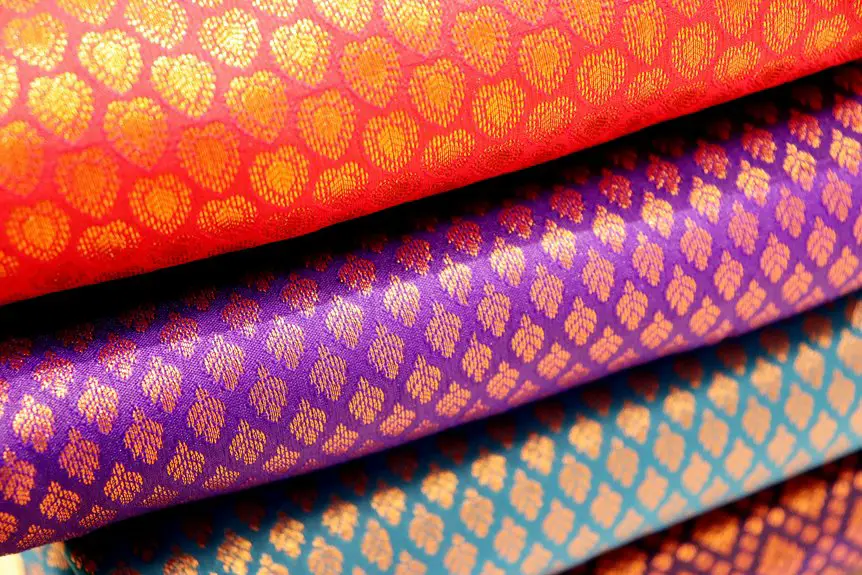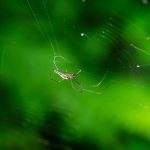Mul Chanderi fabric is a soft, lightweight blend of mulberry silk and cotton from Chanderi, India, known for its smooth texture and subtle sheen. You’ll find it breathable and gentle on your skin, making it perfect for both casual and festive wear. Crafted through traditional handloom techniques by skilled artisans, it offers durability alongside elegance. If you want to uncover its rich cultural roots, unique patterns, and care tips, there’s much more to discover.
Table of Contents
Key Takeaways
- Mul Chanderi fabric is a traditional handloom textile from Chanderi, Madhya Pradesh, combining mulberry silk and cotton for softness and breathability.
- It features a smooth texture with a subtle sheen, lightweight durability, and a delicate yet sturdy weave unique to its craftsmanship.
- The fabric is crafted using age-old weaving techniques passed down through generations of skilled artisans.
- Mul Chanderi is ideal for warm climates, balancing luxury and practicality in sarees, kurtis, scarves, and festive wear.
- It holds cultural significance in India, valued for its elegance, heritage, and support of local artisan communities.
History and Origin of Mul Chanderi Fabric
Although Mul Chanderi fabric has gained popularity in modern fashion, its roots trace back centuries to India, where skilled artisans first crafted this lightweight silk and cotton blend.
Mul Chanderi’s timeless appeal lies in its centuries-old blend of silk and cotton crafted by Indian artisans.
When you explore its origins, you’ll find that Mul Chanderi comes from the town of Chanderi in Madhya Pradesh, a region renowned for its rich textile heritage.
You’ll appreciate how the fabric’s creation involves traditional handloom techniques passed down through generations. These artisans combined silk and cotton to produce a material that feels both soft and breathable, perfect for India’s climate.
As you wear or admire Mul Chanderi, you connect to a legacy of craftsmanship that values quality and artistry, making it far more than just a fabric—it’s a cultural treasure.
Unique Characteristics of Mul Chanderi Weave
When you touch Mul Chanderi fabric, you’ll notice its smooth texture and subtle sheen that set it apart.
The unique weaving techniques blend silk and cotton yarns, creating a lightweight yet durable fabric.
Understanding these characteristics helps you appreciate the craftsmanship behind every piece.
Texture and Appearance
The texture of Mul Chanderi fabric invites you to experience a delicate yet sturdy weave that sets it apart from other silks.
When you touch it, you’ll notice a smooth, lightweight feel that’s surprisingly strong. Its surface carries a subtle sheen, reflecting light softly, giving it an elegant, understated glow.
Unlike heavier silks, Mul Chanderi drapes effortlessly, making it comfortable and flattering to wear. You’ll also observe a fine grain in the fabric, a slight texture that adds depth without roughness.
The colors appear vibrant yet mellow, enhancing its timeless look.
Weaving Techniques Used
A key aspect that makes Mul Chanderi fabric truly special lies in its unique weaving techniques. When you look closely, you’ll notice artisans use a fine blend of silk and cotton threads, woven on traditional handlooms.
This blend creates a lightweight yet durable fabric with a distinct sheen. You’ll appreciate how the weavers interlace these threads meticulously, producing a tight, smooth weave that feels soft against your skin.
The technique involves alternating silk’s lustrous texture with cotton’s breathability, giving Mul Chanderi its signature comfort and elegance. As you run your fingers over the fabric, you’ll understand why this handcrafted method preserves the fabric’s airy, graceful flow, setting it apart from other silks and making it perfect for summer wear.
Materials Used in Mul Chanderi Fabric
You’ll find that Mul Chanderi fabric combines silk and cotton to create its signature lightweight and breathable texture.
The silk used is typically mulberry silk, prized for its smoothness and sheen, while the cotton adds softness and durability. This blend guarantees the fabric feels gentle against your skin yet remains sturdy enough for daily wear.
The silk threads give Mul Chanderi its subtle luster, making it elegant without being flashy. Meanwhile, the cotton fibers enhance comfort, especially in warmer climates, by allowing air to circulate.
Together, these materials give Mul Chanderi its unique balance of luxury and practicality, perfect for those who want a fabric that’s both beautiful and comfortable.
You’ll appreciate how this combination sets Mul Chanderi apart from pure silk or pure cotton fabrics.
Traditional Weaving Techniques Behind Mul Chanderi
You’ll find that Mul Chanderi’s rich history shapes its unique weaving style, passed down through generations.
When you watch the handloom weaving process, you’ll see how skilled artisans carefully select materials and threads to create this elegant fabric.
Understanding these techniques helps you appreciate the craftsmanship behind every piece.
History of Mul Chanderi
Although Mul Chanderi fabric has gained popularity in modern fashion, its roots trace back centuries to traditional weaving communities in India.
You’ll find that its history is deeply intertwined with cultural heritage and skilled craftsmanship passed down through generations.
Mul Chanderi originated in the Chambal region, where artisans perfected the blend of mulberry silk and cotton.
Its story reflects a fusion of elegance and durability, cherished by royalty and common folk alike.
When you explore Mul Chanderi’s history, keep these key points in mind:
- Originates from the Chambal region, known for silk craftsmanship
- Combines mulberry silk with fine cotton yarns
- Woven by skilled artisans preserving ancestral techniques
- Worn traditionally during special occasions and festivals
Understanding this rich background helps you appreciate Mul Chanderi beyond its softness.
Handloom Weaving Process
When you watch skilled artisans work on a Mul Chanderi handloom, you witness a delicate dance of precision and tradition. Each shuttle’s movement weaves the fabric’s unique softness and shimmer, reflecting generations of expertise. The process starts with setting up the warp threads on the loom, followed by meticulous weaving using a fine technique that interlaces silk and cotton threads.
| Step | Action | Purpose |
|---|---|---|
| 1. Warp Setup | Arrange threads on loom | Foundation for weaving |
| 2. Shuttle Weaving | Pass shuttle through | Interlace threads precisely |
| 3. Pattern Formation | Create motifs | Add traditional designs |
| 4. Finishing | Inspect & trim fabric | guarantee smooth texture & quality |
You get a fabric that’s light, breathable, and beautifully elegant.
Materials and Thread Selection
The delicate weaving on a Mul Chanderi loom depends heavily on the quality of materials and threads chosen.
You’ll find that selecting the right fibers is essential to achieving the fabric’s signature softness and sheen. Artisans primarily use fine silk and cotton threads, balancing strength with smoothness.
The thread’s thickness and twist also impact the final texture, so you can’t overlook these details.
When you choose Mul Chanderi materials, consider:
- Pure silk for its lustrous finish
- Long-staple cotton for breathability
- Fine thread count ensuring delicate weave
- Natural dyes to preserve thread integrity
Common Uses and Applications of Mul Chanderi
Since Mul Chanderi fabric combines elegance with durability, you’ll find it widely used in both traditional and contemporary clothing.
You can wear it as sarees, salwar kameez, and dupattas, where its lightweight texture and subtle sheen enhance your look effortlessly. Designers also love Mul Chanderi for making stylish kurtis, skirts, and blouses that keep you comfortable yet fashionable.
Beyond apparel, you might spot this fabric in scarves and stoles, adding a touch of sophistication to your accessories. Its breathable nature makes it perfect for festive occasions and everyday wear alike.
Whether you’re dressing up for a wedding or a casual outing, Mul Chanderi adapts beautifully, offering versatility that suits your modern lifestyle while honoring traditional craftsmanship.
How to Care for Mul Chanderi Textiles
Although Mul Chanderi fabric feels delicate, you can maintain its beauty with simple care steps. Treat this exquisite textile gently to preserve its softness and shine for years. Avoid harsh washing methods, and handle it with care to prevent damage.
Here’s how you can care for your Mul Chanderi textiles:
- Hand wash with mild detergent in cold water to protect the fabric’s fibers.
- Avoid wringing or twisting; gently squeeze out excess water instead.
- Dry in shade to prevent colors from fading under direct sunlight.
- Store in a cool, dry place wrapped in a breathable cloth to avoid moisture buildup.
Following these tips will keep your Mul Chanderi fabric looking elegant and fresh every time you wear it.
Differences Between Mul Chanderi and Other Indian Fabrics
When you compare Mul Chanderi to other Indian fabrics, you’ll notice its unique blend of silk and cotton creates a lightweight yet lustrous texture that sets it apart.
Unlike pure silk fabrics such as Banarasi or Kanjeevaram, Mul Chanderi feels softer and more breathable, making it ideal for warmer climates.
Mul Chanderi offers a softer, more breathable alternative to pure silk, perfect for warm weather.
While cotton fabrics like Khadi are comfortable, they lack the subtle sheen that Mul Chanderi offers.
Mul Chanderi also differs from Chanderi silk, which is usually made from pure silk, by incorporating cotton that enhances durability and ease of maintenance.
If you’re looking for a fabric that balances elegance with everyday wearability, Mul Chanderi stands out as a versatile choice distinct from other traditional Indian textiles.
Popular Designs and Patterns in Mul Chanderi Fabric
If you appreciate intricate craftsmanship, you’ll find Mul Chanderi fabric offers a variety of popular designs and patterns that highlight its elegance.
These patterns balance simplicity and sophistication, making the fabric versatile for many occasions. You’ll notice each design tells a unique story through its weave and motifs.
- Floral Motifs: Delicate flowers woven with fine threads symbolize nature’s beauty.
- Geometric Patterns: Crisp shapes add structure and modern flair, perfect for contemporary tastes.
- Paisley Designs: Classic teardrop shapes that reflect timeless Indian artistry.
- Zari Borders: Metallic threads outline the fabric, adding shimmer and richness.
When you choose Mul Chanderi, you’re embracing these thoughtful patterns that enhance its soft texture and graceful drape.
The Cultural Significance of Mul Chanderi in India
Because Mul Chanderi fabric has been cherished for centuries, it holds deep cultural significance across India.
Mul Chanderi fabric embodies centuries of cherished cultural heritage across India.
When you wear Mul Chanderi, you connect with a rich heritage rooted in tradition, especially in regions like Madhya Pradesh. This fabric often features in weddings and festivals, symbolizing elegance and grace.
You’ll find it admired for its lightweight comfort and subtle sheen, making it a preferred choice for ceremonial attire.
Using Mul Chanderi also supports local artisans who preserve this craft, keeping age-old techniques alive. By choosing this fabric, you’re not just embracing style—you’re honoring India’s skilled weavers and their cultural legacy.
Frequently Asked Questions
Where Can I Buy Authentic Mul Chanderi Fabric Online?
You can buy authentic Mul Chanderi fabric online from trusted Indian ethnic wear stores like Fabindia, Craftsvilla, or Amazon India. Always check product reviews and seller ratings to guarantee you’re getting genuine, high-quality fabric.
Is Mul Chanderi Fabric Suitable for Summer Clothing?
When it comes to beating the heat, Mul Chanderi fabric’s lightweight and breathable nature makes it perfect for summer clothing. You’ll stay cool and comfortable, letting you enjoy sunny days without a sweat.
Can Mul Chanderi Be Blended With Synthetic Fibers?
You can blend Mul Chanderi with synthetic fibers to add durability and reduce wrinkles. However, keep in mind this might affect its natural softness and breathability, so choose blends carefully to maintain comfort and elegance.
What Is the Average Price Range of Mul Chanderi Textiles?
You’ll find Mul Chanderi textiles typically range from $30 to $150, depending on quality and design. Handwoven pieces cost more, but you’ll appreciate their softness and craftsmanship, making the price worth it.
Are There Any Famous Designers Who Specialize in Mul Chanderi?
Imagine draping yourself in silk kissed by morning dew. Designers like Anita Dongre and Sabyasachi specialize in Mul Chanderi, weaving tradition with elegance, so you’ll find their creations both timeless and stunningly soft.
- The Use of Nonwovens in Construction and Civil Engineering - July 11, 2025
- The Use of Nonwovens in Construction and Civil Engineering - July 11, 2025
- The Use of Nonwovens in Construction and Civil Engineering - July 11, 2025







